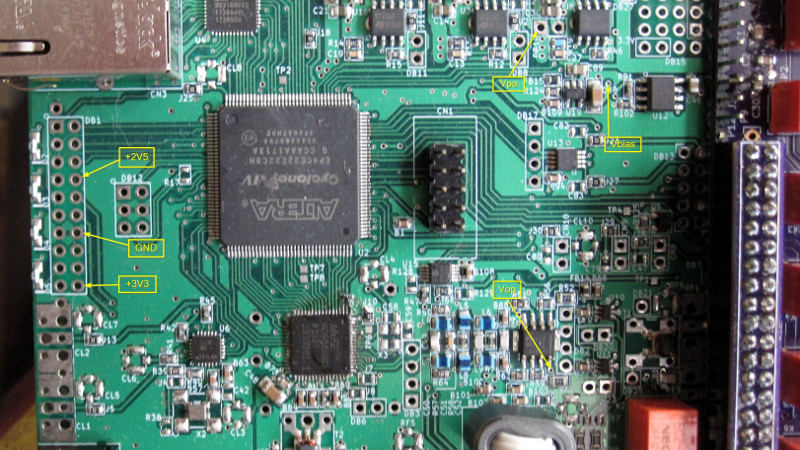It’s a staple of our community’s work, to make electronic devices do things their manufacturers never intended for them. Analogue synthesisers using CMOS logic chips for example, or microcontrollers that bitbang Ethernet packets without MAC hardware. One of the most fascinating corners of this field comes in the form of software defined radios (SDRs), with few of us not owning an RTL2832-based digital TV receiver repurposed as an SDR receiver.
The RTL SDR is not the only such example though, for there is an entire class of cable modem chipsets that contain the essential SDR building blocks. The Hermes-Lite is an HF amateur radio transceiver project that uses an AD9866 cable modem chip as the signal end for its 12-bit SDR transceiver hardware with an FPGA between it and an Ethernet interface. It covers frequencies from 0 to 38.4 MHz, has 384 kHz of bandwidth, and can muster up 5W of output power.
It’s a project that’s been on our radar for the past few years, though somewhat surprisingly this is the first mention of it here on Hackaday. Creator [Steve Haynal] has reminded us that version 2 is now a mature project on its 9th iteration, and says that over 100 “Hermes-Lite 2.0” units have been assembled to date. If you’d like a Hermes-Lite of your own it’s entirely open-source, and they organise group buys of the required components.
Of course, SDRs made from unexpected components don’t have to be exotic.















I built 2 of the original HermesLite 1.x and I have 2 of HermesLite2 Build5 and Build8 both modded to be the same as the latest Build9.
It’s an amazing project – a 5W HF DDC/DUC SDR transceiver for under $300.00 US that really performs and gets the major use here with a RMI Italy 300W PA + eb104.ru HF+6m LPF board. I also have the openHPSDR Hermes + eb104.ru BPF + 300W PA/LPF and a 10W HiQSDR.
Related or not? Kenwood TK 790 modified for modem use only. What do you suppose this means?
Anything using cellular chips?
Ubiquiti has a proprietary 900MHz long range wireless system that’s basically their own implementation of LTE-U.
And they dismounted it completely.
I wish.
Every time I looked in to it datasheets and even baseband interface standards like digirf 2.0 ware non-existent.
And all the baseband stuff or most cable modem chips have no public documentation :(
Yeah. Some parts of EE are really difficult to get into, because it’s technically complex but also because anybody wants you to sign stupid NDA. It’s like with IC from ethernet-switches, no doc available.
They were however some reverse-eng efforts looking at bandbase chips. I think it was presented on some C3 from chaos computer club in Germany??
Lime Micro’s silicon was primarily designed for software designed basestations, but is sold for consumer SDR applications as the LimeSDR and LimeSDR Mini
The ADI Pluto SDR is using some of ADI’s other RFFE chips that handle the cellular bands.
Any projects that actually use old cable modems?
I have one, it’s great radio and amazing project.
There are 20$ ViaSat Surfbeam 2 modems that I’m playing with. These are Ka-Band Satellite links using GEO satellites.
It has:
Cavium OCTEON Plus CN5020-SCP-G
Altera Cyclone III EP3C40F324C8N
TxDAC AD9743BCPZ 2×10-Bit 250 MSPS DAC
AD9600ABCPZ-150 Intermediate frequency (IF) sampling frequencies up to 450 MHz
AD45110 ACPZ (Quadrature Modulator: 950 MHz to 1575 MHz)
ADRF6850 BCPZ 100 MHz to 1000 MHz Broadband Receiver
ADL5602 (ARKZ#JL)- 50 MHz to 4.0 GHz broadband 20 dB linear amplifier
In addition there is ODU unit that operates in Ka-Band:
Input (RX) Frequency 18.3 to 20.2 GHz
Output (TX) Frequency 28.1 to 30.0 GHz
Nominal EIRP 48.4 dBWi
ODU (TRIA) is “smart” it has own LNA, you can change remotely polarization L/R etc over telemetry link.
Project is community driven however I’m sharing details (wiki itp) only to people that can really add some value to it. We are discussing on signalseverywhere’s discord